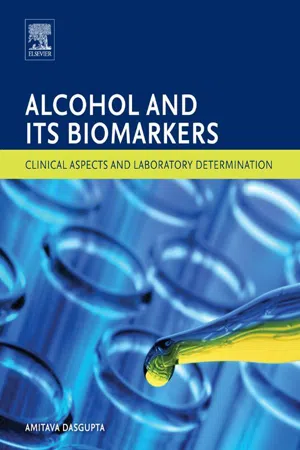
Alcohol and Its Biomarkers
Clinical Aspects and Laboratory Determination
- 312 pages
- English
- ePUB (mobile friendly)
- Available on iOS & Android
About This Book
Alcohol and Its Biomarkers: Clinical Aspects and Laboratory Determination is a concise guide to all currently known alcohol biomarkers, their clinical application, and the laboratory methods used to detect them. Pathologists can use this resource to understand the limitations and cost factors associated with each method for determining certain alcohol biomarkers. In addition, interferences in these determinations are discussed, so that clinicians can understand the causes of falsely elevated biomarkers and pathologists and laboratory scientists can potentially eliminate them. The book focuses on the analytical methods used to detect alcohol in blood and urine, the limitations of alcohol determination using enzymatic methods, and the differences between clinical and forensic alcohol measurement. Chapters also cover cutting-edge alcohol biomarkers for potential use.
- Focuses on the analytical methods used for detecting alcohol in blood and urine along with the pitfalls and limitations of alcohol determination using enzymatic methods
- Explains the difference between clinical and forensic alcohol measurement
- Includes a brief overview of the benefits of consuming alcohol in moderation and the hazards of heavy drinking
Frequently asked questions
Information
Alcohol
Use, Abuse, and Issues with Blood Alcohol Level
Keywords
1.1 Introduction
1.2 Alcohol Consumption: Historical Perspective
1.3 Alcohol Content of Various Alcoholic Beverages
| Beverage | Alcohol Content (%) |
| Standard U.S. beer | 4–7 |
| Table wine | 7–14 |
| Sparkling wine | 8–14 |
| Fortified wine | 14–24 |
| Whiskey | 40–75 |
| Vodka | 40–50 |
| Gin | 40–49 |
| Rum | 40–80 |
| Tequila | 45–50 |
| Brandies | 40–44 |
Table of contents
- Cover image
- Title page
- Table of Contents
- Copyright
- Preface
- Chapter 1. Alcohol: Use, Abuse, and Issues with Blood Alcohol Level
- Chapter 2. Genetic Aspects of Alcohol Metabolism and Drinking Behavior
- Chapter 3. Measurement of Alcohol Levels in Body Fluids and Transdermal Alcohol Sensors
- Chapter 4. Alcohol Biomarkers: An Overview
- Chapter 5. Liver Enzymes as Alcohol Biomarkers
- Chapter 6. Mean Corpuscular Volume and Carbohydrate-Deficient Transferrin as Alcohol Biomarkers
- Chapter 7. β-Hexosaminidase, Acetaldehyde–Protein Adducts, and Dolichol as Alcohol Biomarkers
- Chapter 8. Direct Alcohol Biomarkers Ethyl Glucuronide, Ethyl Sulfate, Fatty Acid Ethyl Esters, and Phosphatidylethanol
- Chapter 9. Less Commonly Used Alcohol Biomarkers and Proteomics in Alcohol Biomarker Discovery
- Chapter 10. Genetic Markers of Alcohol Use Disorder
- Index